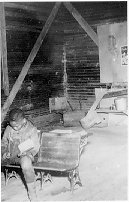| History of Black Education | |
|
|
| To better understand the status of blacks in education between the years 1950-1975, one must have an understanding of the historical events shaping that status. An understanding of social political status of Black Americans is needed. |
| Ever since the days of slavery, constraining black education was used as a method to quell
black agency and fears of slave rebellions. This denial only intensified Black people's desire for education. After
emancipation, black education was relegated to poorly funded segregated schools. During this period, two leaders emerged with conflicting philosophies regarding Black education, W.E.B. DuBois and Booker T. Washington. |
 |
| History of Black Higher Education | |
| In higher education, several Black institutions were formed under the auspices of the Freedman's Bureau and the American Missionary Association, to help create black clerics and provide a Christian education for the Black "heathens." Simultaneously, Southern black institutions, segregated schools that largely depended on white philanthropy to exist, focused on industrial education that would prepare blacks for subservient roles in society. These institutions were in most cases, academically inferior to white institutions. The first Black American student graduated from Bowdoin College in 1890. Black students did not begin to enter predominately white schools in significant numbers until the 1960s. | |
-Education of Blacks in Ohio |
|
| Although from the mid to the late 1800s, Ohio had more colleges that any other state in America, the acceptance and enrollment of black students was relatively small. With the notable exception of Oberlin College (1833), which was open to black students as early as 1835, only two years after it open, Ohio's campuses were overwhelming white institutions with scarce Black students representation. Like Kenyon, these schools. Perhaps the establishment of Wilberforce University (1856) in Southern Ohio may have contributed to this. |
Education in the 1950s |
|
While some universities would require federal urging to open their enrollment to black students, these were primarily larger state universities. Many private colleges never explicitly forbade blacks, but practiced a de facto segregation. Before the black enrollment boom of the late 1960s, some schools, such as Kenyon, began to investigate the possibilities of recruiting qualified black students. There were sparse scatterings of solitary black students beginning to integrate all white campuses. Contributing factors included the Great Migration, the economic gains of World War II, military desegregation, and the Brown v. Board of education case. These all brought hope to black Americans regarding their children's education. |
| Education in the 1960s | |
|
|
| The 1960s was a time of great turmoil and social unrest in America and in the Black community. At this time, more blacks began to attend predominately white institutions at an increasing rate. Moreover, toward the end of the decade, more blacks were choosing to attend predominately white institutions than were choosing to attend historically black colleges and universities. Sociologist Jacqueline Fleming discovered that while black students chose white institutions because of better academic reputations, financial aid, and academic resources superior to those at black colleges, the presence of racism or an environment that is hostile impedes these benefits for blacks. Fleming's studies show that black students tend to perform better and exhibit more personal growth at historically black institutions. | |
| Many believe that the assassination of Martin Luther King Jr. prompted not only an increase in campus black political activity, but also an increase in administrative responsiveness to black student demands. The demands of these activists typically included more black students, increased black faculty, and the establishment of black studies programs. Kenyon was no exception. |